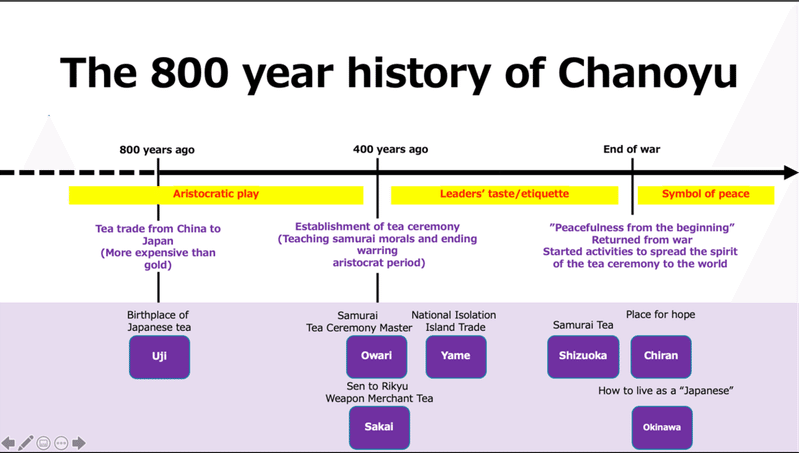#5_「茶の湯」と「茶道」の違いとは? What is the difference between "Chanoyu" and "Chadou"?
皆さんは、冒頭の問いに何と答えますか?
What do you think about the question at the beginning of this article?
その定義について、当法人がご指導いただいている小泉宗敏先生は、
Dr. Koizumi, one of our instructors, gave us a definition of the Chanoyu and Chadou.
==========
「茶道」は「道」なので厳しいが、
Chadou is strict because it is a "way" of tea.
「茶の湯」は「楽しむこと」がその真髄である
On the other hand, Chanoyu has a more enjoyable, rather than strict essence.
==========
と、教えてくださっています。
I will teach you.
では、なぜそのような違いが生まれるのでしょうか?ヒントは、その歴史的な起源にあります。
So why are there such differences? The clue lies in its historical origins.
日本茶文化の歴史
History of Japanese Tea Culture
英語の図になりますが、私たちは「日本茶文化1000年の歴史」を以下のように整理しています。
As you can see in the diagram in English, we have organized the "1000 years of Japanese tea culture" as follows.

ポイントは、今からおよそ400年前、千利休によって「茶道」が確立されたところにあります。
The point is that the tea ceremony was established by Sen no Rikyu about 400 years ago.
お茶が金よりも高価だった時代
A time when tea was more expensive than gold.
お茶は今から800年前、中国より日本にやってきました(文献によっては1000年前の平安時代より貴族に嗜まれていた様子がうかがえます)。当時、「薬」としてやってきた茶は、金よりも高価なものでした。
Tea came to Japan from China 800 years ago (according to documents, tea was enjoyed by aristocrats from the Heian period, 1000 years ago). At that time, tea, which came to Japan as "medicine," was more expensive than gold.
結果、「茶」は貴族のみが手に入るものであり、色彩美が最も発達したと言われる「平安の雅な文化」を代表するように、陽気な日本人によって「楽しく」嗜まれてきたものでした。これが、「茶の湯の精神」の源流となっています。
As a result, tea was only available to the aristocracy, and it was enjoyed "happily" by the cheerful Japanese people, representing the "elegant culture of the Heian period" where the beauty of colors was said to be most developed. This is the origin of the "spirit of Chanoyu".
お茶が武士道と交差し「茶道」になった時代
When Tea Intersected with Bushido and Became the Way of Tea
今からおよそ400年前、千利休が「茶道」を確立しました。
About 400 years ago, Sen no Rikyu established the "tea ceremony"-茶道.
戦国時代であった当時の日本において、戦いに明け暮れる「武士」たちに、「道徳」「倫理」を教え、戦国時代の終わりに貢献したと言われる「茶道」は、それ以前より茶文化によって継承されてきた「和の精神」に加えて「武士道の精神」を色こく反映しました。
The tea ceremony is said to have contributed to the end of the Warring States period in Japan by teaching morality and ethics to the warriors who spent all their time fighting. In addition to the "spirit of harmony" that had been inherited from earlier tea cultures, the tea ceremony also started to reflect the spirit of Bushido. That's how 茶道 was established.
そして、これ以降「茶道」は国を治めるリーダーの嗜みとして、明治維新以降も継承されてきました。
Since then, the tea ceremony has been carried on as a way of life for leaders who govern the country, even after the Meiji Restoration.
違いの本質
The Essence of the Difference
では、この二つの違いの本質は何でしょうか?
So, what is the essence of the difference between the two?
「茶道」においては厳しいルールを守ることが求められます。そして、そのルールや所作一つ一つに対する捉え方は流派により異なるため、その「道」に入るためには自分で「ここだ」と決めた流派の門を叩く必要があります。
In the tea ceremony, strict rules are required to be followed. And since the rules and the way of thinking about each and every gesture differ from school to school, in order to enter the "way" of the tea ceremony, you have to knock on the door of the school you have decided to follow.
一方の「茶の湯」は、同じく千利休の言葉にもある通り、「湯を沸かし、自然(の神々)に感謝し、茶をゆっくりと味わう」、これを「自分のスタイルで愉しむこと」を嗜むこと、これを追求することが一番大事なことです。
On the other hand, "Chanoyu" is, as Sen no Rikyu said, "to boil water, to thank nature (the gods), and to taste tea slowly. The most important thing is to pursue this, to enjoy it in your own style.
茶道ではなく「茶の湯外交」としている意味
The meaning of "Chanoyu Diplomacy" instead of "Tea Ceremony"
私たちは、世界に日本を紹介する際の「入口」、あるいは日本に関心を持っていただく「呼水」となる茶を目指しています。
Our goal is to create a tea ceremony that will serve as a "gateway" to introduce Japan to the world, or as a "catalyst" for people to become interested in Japan.
よって、「茶の湯」を通して関心を持っていただけ、結果「さらに学びたい」という方にお会いした際には、「日本にはいろいろな流派がございますので、お好きな扉をノックしてみてください」とお伝えしています。
Therefore, when we meet people who are interested in learning more about Japan through chanoyu, we tell them that there are many different schools in Japan, so please knock on the door of your choice.
この記事が気に入ったらサポートをしてみませんか?
